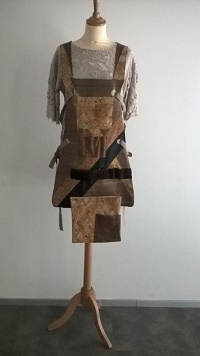
Forests are on the catwalk again, making sustainability more fashionable than ever. The initiative “Forests for Fashion” was first launched in 2014 by UNECE and the Food and Agriculture Organization of the UN (FAO). Since then it has inspired other initiatives and partners to join forces and contribute to the development of the concept. The “Forests for Fashion – Fashion for Forests” publication, released in June 2017, provides deeper insights into what happens when sustainable forest management meets sustainable fashion trends.
The programme for the Endorsement of Forest Certification (PEFC) has now taken the lead in the initiative, working with young designers to bring the trend to a wider audience, while ensuring that forest-based materials originate from sustainably managed forests. The Forests for Fashion Show on Friday 23 June 2017 features creations of students of the Italian Design Institute in Perugia, Italy. Clothing derived from cork and yarns from cypress, beech and eucalyptus trees provide greater softness than silk and cotton, and at the same time are more breathable; innovative fabrics reminiscent of the most valuable animal skins are obtained from deciduous and coniferous European forests.
Fashion does not always have a sustainable image. It is often associated with promoting excessive and unsustainable consumption, using materials that are not environmentally friendly, and, in many cases, relying on indecent labour conditions. However, the fashion industry is worth six times more than the forest industry and can have a domino effect in encouraging more sustainable and ethical production and consumption patterns.
Fashion can learn from the long-term thinking of the forester. Trees grow slowly; the foresters who plant trees are not the ones who harvest them - an oak tree for example reaches maturity only after 180 years. The pace of unsustainable production and consumption in the fashion sector has led to its label of “fast fashion”. Today, there is growing recognition of the need for the fashion industry to slow down and reconnect with its traditional purpose. Producing better quality, longer-lasting garments is an important step towards more sustainable consumption. For instance, it was estimated that extending the average life span of clothes by just nine months could reduce the carbon, water and waste footprint by 20-30%. Moreover, aiming at quality and certified products stimulates the use of natural materials and improves the supply chain in terms of legality and sustainability. For forest-based fashion products, more qualified expertise is needed to meet demand for high quality materials.
Collaboration between forest and fashion stakeholders can provide a visible and meaningful contribution to the implementation of the 2030 Agenda for Sustainable Development. The fashion industry in particular offers two entry points for action: top down, as governments and business corporations have the power to foster change; and bottom up, as consumers have a choice when buying garments and can therefore influence production and markets.

